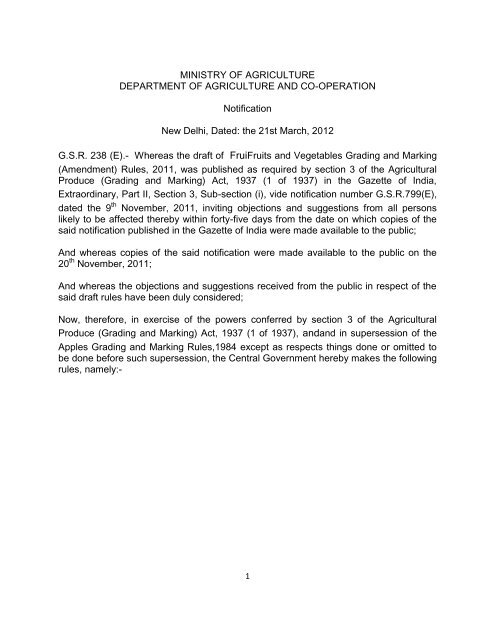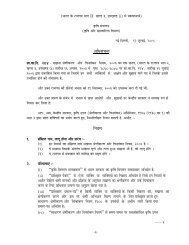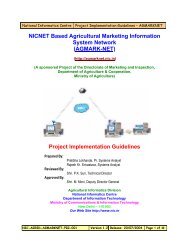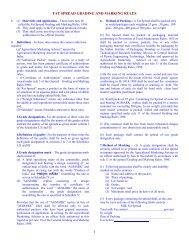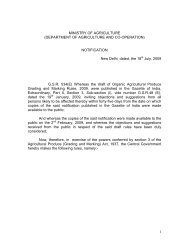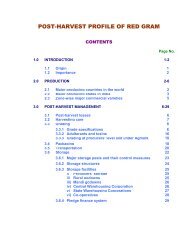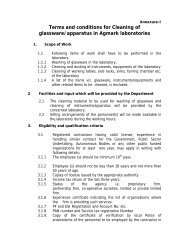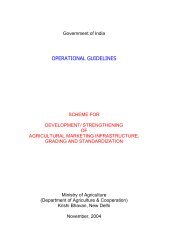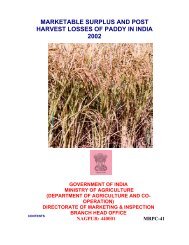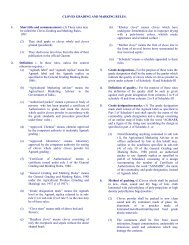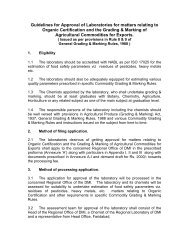Fruits and Vegetables Grading and Marking Rules, 2012 - Agmarknet
Fruits and Vegetables Grading and Marking Rules, 2012 - Agmarknet
Fruits and Vegetables Grading and Marking Rules, 2012 - Agmarknet
You also want an ePaper? Increase the reach of your titles
YUMPU automatically turns print PDFs into web optimized ePapers that Google loves.
3. Criteria For Grade Designation:GradedesignationExtraclassClass -IClass-IIGrade requirementsApples in this class must be of superior quality.The flesh must be sound. They shall becharacteristic of the variety <strong>and</strong> they must be freeof defects, with the exception of very slightsuperficial defects, provided these do not affect thegeneral appearance of the produce, the quality, thekeeping quality <strong>and</strong> presentation in the package.(five percent of the fruits may have the defects asgiven in Table A)Apples in this class must be of good quality. Theflesh must be sound <strong>and</strong> they must becharacteristic of the variety. Provided that thefollowing do not amount to defect if they do notaffect the general appearance of the produce, thequality, the keeping quality <strong>and</strong> presentation in thepackage which have:-a slight defect in shape <strong>and</strong> development;- a slight defect in colouring;- slight skin or other defects.(ten percent of the fruits may have the defects asgiven in Table A)This class includes apples, which do not qualify forinclusion in the higher classes, but satisfy theminimum requirements. Provided that the followingdo not amount to defect if the apples retain theiressential characteristics as regards the quality, thekeeping quality <strong>and</strong> presentation which have:- defects in shape <strong>and</strong> development;- defects in coloring;- skin or other defects.(ten percent of the fruits may have the defects asgiven in Table A)Grade tolerancesFive percent by number or weightof apples not satisfying therequirements of the grade, butmeeting those of Class-I or,exceptionally, coming within thetolerances of that grade. Includedtherein shall be allowed not morethan 1% for apples affected byinternal breakdown.Ten percent by number or weightof apples not satisfying therequirements of the grade, butmeeting the requirements of gradeII.Included therein shall be allowednot more than 1% for applesaffected by decay or internalbreakdownTen percent by number or weightof apples not satisfying therequirements of the grade, butmeeting the minimumrequirements, with the exceptionof apples affected by decay orinternal breakdown that should notbe more than two percent.Included therein shall be allowed,maximum of 2% by number orweight of fruits which may showthe following defects: cork like blemishes(bitter pit) slight damage or unhealedbroken skin/cracks.4
Russetting outsideCalyx/ stem cavityTABLE A- DEFECT TOLERANCESDefects Allowed Extra Class Class I Class IIAccumulation for both types ofrussetting should not exceedsmooth netlike1 %of surface area3%of surface area Smooth solid 1 % 1 %of surface area5 %of surfacearea3 %of surfacearea1 % 3 % 5 %Accumulated Blemishes & BruisingincludingNil1 Sq. cm2 Sq. cm-Within this limit scar caused by scabs*(Venturia inaequalis) shall not exceed.Nil0.25 Sq.cm0.5 Sq. cmStem or Calyx cracks (healed or wellcured)Maximum length of elongated shapeddefectsNil 0.5 cm 1 cmNil 1 cm 2 cm* This provision applies without prejudice to the applicable Plant Protection <strong>Rules</strong>.4. Other Requirements:(i)(ii)(iii)(iv)Apples must have been carefully picked <strong>and</strong> have colour that is characteristic ofthe variety. The development <strong>and</strong> condition of the apples must be such as toenable them:- to reach the appropriate stage of physiological maturity corresponding tothe particular characteristics of the variety;- to withst<strong>and</strong> transport <strong>and</strong> h<strong>and</strong>ling, <strong>and</strong>- to arrive in satisfactory condition at the place of destination.The contents of each package must be uniform <strong>and</strong> contain only apples of thesame origin, variety, quality, size <strong>and</strong> same degree of ripeness.The Extra Class fruits must be packed in layers only.The apples in Class-I <strong>and</strong> Class-II may be presented in one of the followingfforms, namely:-5
(v)(vi)(vii)- in regular layers according to size;- in open or closed containers;- loose in consumer packages;- shipping packages (master containers or cartons); or- in bulk or pallet bins.Consumer packages (of net weight not exceeding 5 Kg) may contain mixture ofvarieties, provided they are of uniform grade designation <strong>and</strong> each variety is ofthe same origin. The visible part of the content of the package must berepresentative of the entire content.Other than bulk or pellet packing, the maximum net weight of the fruits shall notexceed 20Kg.Stickers shall be affixed to each produce so that, when removed ,they neitherleave visible traces of glue, nor lead to skin defects.5. Provisions Concerning Size(i)Size code is determined by the diameter in millimeter of the equatorialsection or weight of the fruit in grams in accordance with the Table B asfollows:TABLE B - SIZE CODESize code Diameter in mm Weight in gmA More than 80 More than 241B 76-80 211-240C 71-75 181-210D 66-70 151-180E 61-65 121- 150F 56-60 91-120G 50-55 60-90(ii)Size Tolerances: For all classes, 10% by number or weight of apples notsatisfying requirements of the size code.6. Colouring Criteria For Apples:Following shall be the colouring criteria for different grades of apples of differentvarieties except for green <strong>and</strong> yellow apple varieties.Grade Percentage characteristic colour ofthe varietyExtra class85 or moreClass-I70 or moreClass-II Less than 706
Explanation for the purpose of this ruleeee,-(a)(b)(c)(d)“blemish” means superficial bruising which is not covered under other defects.“flesh defects” means visible water core <strong>and</strong> internal or external bitter pit.“other skin defects” means defects due to hail (healed), limb damage, dark brownor black marks produced by branches, insect pest <strong>and</strong> disease spot not resultingin skin punctures.“russetting” means particular type of skin, abnormal roughening or streak <strong>and</strong>scarring of the fruit surface, which characteristically is smooth.7
Schedule-XLIVGRADE DESIGNATION AND QUALITY OF BITTER GOURD1. Bitter gourds shall be obtained from varieties (cultivars) ofMomordica charantia L. of Cucurbitaceae family.2. Minimum requirements:(i) Bitter gourds shall be -(a) whole, the stalk may be present provided it is clean <strong>and</strong> neatly cut ;(b) fresh in appearance <strong>and</strong> having well developed tubercles;(c) firm;(d) sound, produce affected by rotting or deterioration such as to make it unfitfor consumption shall be excluded;(e) clean, free of any visible foreign matter;(f) free from pests, larvae <strong>and</strong> mites;(g) free from damage caused by the pests;(h) free from abnormal external moisture;(i) free from any foreign smell or taste;(j) free from damage caused by low <strong>and</strong> high temperature;(k) free from skin puncture;(l) free from dehydration, water soaking <strong>and</strong> shriveling;(m) free from internal or over-developed blackening;(n) free from hard seeds <strong>and</strong> red seeds;(o) free from flowers.(ii)(iii)Bitter gourd shall comply with the residue levels of pesticides, heavymetals <strong>and</strong> other food safety requirements as laid down by the CodexAlimentarius Commission for exports or requirements of the importingcountry.Bitter gourds must not be less than 70 mm of length without stem or stalk.8
3. Criteria For Grade Designation:GradedesignationExtra classClass- IClass-IIGrade requirementsBitter gourds in this class must be ofsuperior quality. In shape, size <strong>and</strong>colour, they must be characteristic of thevariety. Stalk must be intact <strong>and</strong> fleshmust be perfectly sound. They must befree from defects, with the exception ofvery slight superficial defects, providedthese do not affect the generalappearance of the produce, the quality,the keeping quality <strong>and</strong> presentation in thepackage.Bitter gourds in this class must be withneatly cut stems.Bitter gourd must be of good quality. Inshape, sizing <strong>and</strong> colour, they must becharacteristic of the variety. Provided thatthe following do not amount to defect ifthey do not affect the general appearanceof the produce, the quality, the keepingquality <strong>and</strong> presentation in the packagewhich have:- a slight defect in shape <strong>and</strong>development;- a slight defect in colour;- slight skin defects(scratches, scars,scraps <strong>and</strong> blemishes) not to exceed2 sq.cm. cumulative area of the totalsurface area;.- slight bruising not exceeding 1 sq.cm of total surface area causingdiscoloration.The skin defects must not affect the pulp.This includes bitter gourds which do notqualify for inclusion in the higher gradesbut satisfy the minimum requirements.9Grade tolerances5% by number or weightof bitter gourd notsatisfyingtherequirements of thegrade, but meetingthose of Class-I or,exceptionally, comingwithin the tolerances ofthat grade.10% by number orweight of bitter gourdnot satisfying therequirements of thegrade, but meetingthose of Class-II orexceptionally, comingwithin the tolerances ofthat grade.- 10% by number orweight of bittergourd not satisfying
Provided that the following do not amountto defect if the bitter gourds retain theiressential characteristics as regards thequality, the keeping quality <strong>and</strong>presentation:- defects in shape <strong>and</strong> development;- defects in colour.- skin defects (scratches, scars, scraps<strong>and</strong> blemishes) not to exceed 4 cm.cumulative area of total surface area.the requirements ofthe grade, butmeeting theminimumrequirements.The skin defects must not affect the pulp.4. Other requirements:(i) Bitter gourds must have been carefully picked <strong>and</strong> have colour that ischaracteristic of the variety <strong>and</strong> to the area in which they are grown. Thedevelopment <strong>and</strong> condition of the bitter gourds must be such as to enable them:-(ii)- to reach the appropriate stage of maturity corresponding to the particularcharacteristics of the variety;- to withst<strong>and</strong> transport <strong>and</strong> h<strong>and</strong>ling, <strong>and</strong>- to arrive in satisfactory maturity condition at the place of destination <strong>and</strong>should not become yellow or should not show the indications of ripening.For Extra Class bitter gourds must be packed in layers but sufficiently separatedfrom each other.(iii) Bitter gourds may be presented in one of the following forms, namely:-(a) in regular layers according to size;(b) in open or closed containers;(c) loose in consumer packages;(d) shipping packages (master containers or cartons); or(e) in bulk or pallet bins (retail display or promotion).(iv) It shall be marked on the package according to the colour of the bitter gourdspacked:- Light green- Green- Whitish10
5 .Provisions Concerning Sizing:-(A) i) The size of the bitter gourd shall be determined by the length withoutstem/stalk in mm.Size code Length in mmwithout stemA* 40-70B 70-100C 101-140D 141-180E 181-230F 231 <strong>and</strong> aboveii) *Size Code “A” shall be marked as “Baby bitter gourd.”(B) Size tolerances:For all classes: 10% by number or weight of bitter gourd not satisfyingrequirements of the size code.11
Schedule-XLVGRADE DESIGNATION AND QUALITY OF BOTTLE GOURD OR LAUKI1. Bottle Gourd or Lauki or Ghiya shall be obtained from varieties (cultivars) ofLagenaria siceraria (Molina) St<strong>and</strong>l. of family Cucurbitaceae.2. Minimum requirements:(i) Bottle gourd shall be -(a) whole;(b) firm;(c) intact;(d) fresh in appearance (shining skin);(e) well trimmed (neatly cut stalk with 2-10 cm length from the shoulder ofthe fruit)(f) clean, free of any visible foreign matter;(g) free from bruising or extensive healed overcuts;(h) free from damage caused by pest or diseases;(i) free from abnormal external moisture, excluding condensation followingremoval from cold storage;(j) free from foreign smell or taste;(k) free from signs of internal shriveling or dehydration or water-soaking;(l) free from damage caused by low temperature or high temperature orfrost;(m)free from chemical traces, artificial colour;(n) free from grittiness of skin;(o) free from fissures or cavities on the surface; <strong>and</strong>(p) free from internal blackening or red colour of flesh or seeds.(ii) Bottle gourds shall comply with the residue levels of heavy metals,pesticides <strong>and</strong> other food safety requirements as laid down by the CodexAlimentarius Commission for exports or requirements of the importingcountry.12
3. Criteria For Grade Designation:GradedesignationsGrade requirementsGrade tolerances1 2 3Extra class Bottle gourd must be of superior quality. Theymust be characteristic of the variety <strong>and</strong>/orcommercial type in shape, external appearance,development <strong>and</strong> colour. They must be free ofdefects, with the exception of very slight superficialdefects provided they do not affect the generalappearance of the produce, the quality, thekeeping quality <strong>and</strong> presentation in the package.bottle gourd must be uniform in colour. They mustbe:Class -I- well developed;- have a typical colour for the variety; <strong>and</strong>- free of defects including all deformations <strong>and</strong>particularly those caused by seed formation.Bottle gourd must be of good quality. They mustbe characteristics of the variety or commercial typein shape.They must ;- reasonably developed; <strong>and</strong>- reasonably well shaped.Provided that the following do not amount to defectif they do not affect the general appearance of theproduce, the quality, the keeping quality <strong>and</strong>presentation in the package.-- a slight deformation, but without seedformation;- a slight defect in colour especially the lightcoloured part of the bottle gourd where ittouched the ground during growth;- slight skin blemishes due to rubbing <strong>and</strong>h<strong>and</strong>ling or low temperatures not to exceed 55 % by number orweight of bottlegourd notsatisfying therequirements ofthe grade, butmeeting those ofClass I grade or,exceptionally,coming within thetolerances of thatgrade.10 % by number orweight of bottlegourd notsatisfying therequirements ofthe grade, butmeeting those ofClass II or,exceptionally,coming within thetolerances of thatgrade.13
Class -IIpercent of the total surface area, providedthat such blemishes have healed <strong>and</strong> do notaffect the keeping quality.The defect must not affect the pulp.This class includes bottle gourds which do notqualify for inclusion in the higher classes butsatisfy the minimum requirements. Provided thatthe following do not amount to defect, namely:-- deformation other than serious seeddevelopment;- defects in colour up to one-twentieth of thesurface;- considerable discoloration in the affected partare not allowed;- healed cracks not affecting the pulp;- slight damage caused by rubbing <strong>and</strong>h<strong>and</strong>ling not exceeding 10 percent of the totalsurface area, provided which does notseriously affect the keeping quality <strong>and</strong>appearance.- Slight pale colour due to ground touchingduring growth.The defects must not affect the flesh.10 % by number orweight of bottlegourd notsatisfying therequirements ofthe grade, butmeeting theminimumrequirements.4. Other requirements:(i)Bottle gourd must have been carefully picked <strong>and</strong> have reached anappropriate degree of development <strong>and</strong> display satisfactory maturity inaccordance with criteria proper to the variety <strong>and</strong> to the area in which they aregrown. The development <strong>and</strong> condition of the bottle gourd must be such asto enable them;- to withst<strong>and</strong> transport <strong>and</strong> h<strong>and</strong>ling, <strong>and</strong>- to arrive in satisfactory condition at the place of destination.(ii)The content of each package must be uniform <strong>and</strong> contain only bottle gourdsof the same origin, variety, quality, size, same degree of maturity <strong>and</strong>development.14
(iii)(iv)(v)Bottle gourds must be packed sufficiently tightly so as to avoid damage duringtransport.In case of short bottle gourd, it shall be marked on the package “Early bottlegourd”.Bottle gourd may be marked as per shape.-- Cylindrical- Club shaped- Globular- Goose-necked- Elongated- Oblong- Flattened- Cervical5. Provision Concerning Sizing:(A) size is determined by the length or weight of the bottle gourd.(i) Length:Size Code Length in cmwithout peduncleAupto20B 21-30C 31- 40D 41-50E51<strong>and</strong> above(ii) Weight:Size Code Weight in gramsA Below 200B 201-400C 401-600D 601-800E 801-1000F 1001-1200G 1201-1500H Above 1500Size code G&H shall not be applicable for extra class <strong>and</strong> class-I.(B) Size tolerances:15
For all classes: 10% by number or weight of bottle gourd not satisfying requirements ofthe size code.Schedule - XLVIGRADE DESIGNATION AND QUALITY OF SPONGE GOURD1. Sponge gourd shall be obtained from varieties (cultivars) of Luffa cylindricaof family Cucurbitaceae.2. Minimum requirements:(i) Sponge gourd shall be:-(a) whole (with stalk);(b) firm;(c) intact,(d) fresh in appearance;(e) sound with characteristic shape of the variety, produce affected byrotting or deterioration such as to make it unfit for consumption isexcluded;(f) clean, free of any visible foreign matter (properly drained, if washed);(g) free from bruising or extensive healed overcuts;(h) free from damage caused by pest or diseases;(i) free from abnormal external moisture, excluding condensation followingremoval from cold storage;(j) free from foreign smell or taste;(k) free from signs of internal shriveling or dehydration or water-soaking;(l) free from damage caused by low temperature or high temperature orfrost;(m) free from bitter taste;(n) free from grittiness of skin;(o) free from fissures, cavities;(p) free from internal blacking <strong>and</strong> hard fiber formation;(q) free from black or yellowish spots.(ii)Sponge gourd shall comply with the residue levels of heavy metals,pesticides <strong>and</strong> other food safety requirements as laid down by theCodex Alimentarius Commission for exports or requirements of theimporting country.16
3. Criteria for Grade Designation:GradedesignationsGrade requirementsGradetolerances1 2 3Extra classClass- ISponge gourd must be of superior quality. They must becharacteristic of the variety or commercial type in shape,external appearance, development <strong>and</strong> colour. Theymust be free of defects, with the exception of very slightsuperficial defects provided they do not affect the generalappearance of the produce, the quality, the keepingquality <strong>and</strong> presentation in the package. sponge gourdmust be uniform in colour.They must be:-Well trimmed with neatly cut stem (Peduncle up to 5cm);-well developed;- well shaped <strong>and</strong> practically straight (maximum height ofthe arc: 10 mm per 20 cm of length of the sponge gourd);-have a typical colour of the variety; <strong>and</strong>-free of defects including all deformations <strong>and</strong>particularly those caused by seed formation (blackcoloured seeds).Sponge gourd must be of good quality. They must becharacteristics of the variety <strong>and</strong>/or commercial type.They must be ;- reasonably developed;- reasonably well shaped <strong>and</strong> straight (maximum175 % bynumber orweight ofsponge gourdnot satisfyingtherequirementsof the grade,but meetingthose ofClass I gradeor,exceptionally,coming withinthe tolerancesof that grade.10 % bynumber orweight ofsponge gourdnot satisfyingtherequirements
height of the arc: 10 mm per 15 cm of the length ofsponge gourd).Provided that the following do not amount to defect if theydo not affect the general appearance of the produce, thequality, the keeping quality <strong>and</strong> presentation in thepackage.-- slight deformation;of the grade,but meetingthose ofClass II or,exceptionally,coming withinthe tolerancesof that grade.Class II- slight defect in colour, slight pale especially the lightcoloured part of the sponge gourd where it touched theground during growth; <strong>and</strong>-slight skin blemishes due to rubbing <strong>and</strong> h<strong>and</strong>ling orlow temperatures not to exceed 5 percent of the totalsurface area, provided that such blemishes have healed<strong>and</strong> do not affect the keeping quality.The defect must not affect the flesh.This class includes sponge gourd which do not qualify forinclusion in the higher classes but satisfy the minimumrequirements: Provided that the following do not amountto defect if the sponge gourds retain their essentialcharacteristics as regards the general appearance, thequality, the keeping quality <strong>and</strong> presentation in thepackage which have -- deformation other than seed development;- defects in colour up to one-tenth of the surface;- considerable defects in colour in the affected part arenot allowed;-healed cracks provided not affecting the flesh;a. - slight damage caused by rubbing <strong>and</strong> h<strong>and</strong>ling not toexceed 10 percent of the total surface area.b.c. The defects must not affect the flesh.Slightly crooked Sponge Gourd may be allowed in this10 % bynumber orweight ofSpongeGourd notsatisfying therequirementsof the grade,but meetingthe minimumrequirements.18
Class which has a maximum height of the arc of 20 mmper 20 cm of length of the Sponge Gourd.4. Other Requirements:(i)Sponge gourd must have been carefully picked <strong>and</strong> have reached anappropriate degree of development <strong>and</strong> display satisfactory maturity inaccordance with criteria proper to the variety <strong>and</strong> to the area in which they aregrown. The development <strong>and</strong> condition of the sponge gourd must be suchas to enable them-- to withst<strong>and</strong> transport <strong>and</strong> h<strong>and</strong>ling, <strong>and</strong>- to arrive in satisfactory condition at the place of destination. It should notbecome yellowish/pale.(ii)(iii)(iv)(v)(vi)In Extra Class, the content of each package must be uniform <strong>and</strong> containonly sponge gourds of the same origin, variety, quality, size, same degree ofmaturity <strong>and</strong> development.Crooked sponge gourd having a greater arc than 20 mm per 10 c.m. length ofthe sponge gourd must be packed separately <strong>and</strong> marked “Crooked spongegourd” in the package.Sponge gourd must be packed sufficiently tightly so as to avoid damageduring transport.In case of short sponge gourd, it shall be marked on the package “Shortsponge gourd” or “Mini-sponge gourd”.It shall be marked on the package according to the colour of the spongegourd –- Green, if the green colour is more than 80% of the total surface area.- Dark green, if the dark green colour is more than 90% of the total surfacearea.(vii)Sponge gourd may be presented in one of the following styles:-- In regular layer according to size;- In open or closed container;- Loose in consumer package;- In shipping packages.19
5. Provisions Concerning Sizing:(A)Sizing is determined by the weight of the Sponge Gourd-Size Weight In gramscodeA Up to 200B 201 to400C 401to600D 601to 800E 801 to1000F 1001 to1200G 1201to 1500H Above 1500(B)Size tolerances:For all classes: 10% by number or weight of sponge gourd not satisfyingrequirements of the size code.20
Schedule-XLVIIGRADE DESIGNATION AND QUALITY OF CUCUMBERS1. Cucumbers shall be obtained from varieties (cultivars) of Cucumis sativas L. cucumbersfor processing <strong>and</strong> gherkins are being excluded.2. Minimum requirements:(i) Cucumbers shall be -(a) whole;(b) firm;(c) intact,(d) fresh in appearance;(e) sound with characteristics shape of the variety, produce affected by rotting ordeterioration such as to make it unfit for consumption is excluded;(f) clean, free of any visible foreign matter;(g) free from bruising <strong>and</strong>/or extensive healed overcuts,;(h) free from damage caused by pest or diseases;(i) free from abnormal external moisture, excluding condensation following removalfrom cold storage;(j) free from foreign smell <strong>and</strong>/or taste;(k) free from signs of internal shriveling/dehydration or water-soaking;(l) free from damage caused by low temperature <strong>and</strong>/or high temperature or frost;(m) free from bitter taste;(n) free from hard seeds inside;(o) free from grittiness of skin;(p) free from fissures; <strong>and</strong>(q) free from stalk or flower.(ii) Cucumbers shall comply with the residue levels of heavy metals, pesticides <strong>and</strong>other food safety requirements as laid down by the Codex Alimentarius Commission forexports or requirements of the importing country.21
3. Criteria For Grade Designation:GradedesignationsGrade requirementsGrade tolerances1 2 3Extra classCucumbers must be of superior quality. They must becharacteristic of the variety <strong>and</strong>/or commercial type inshape, external appearance, development <strong>and</strong> colour.They must be free of defects, with the exception of veryslight superficial defects provided they do not affect thegeneral appearance of the produce, the quality, thekeeping quality <strong>and</strong> presentation in the package.Cucumbers must be uniform in colour. They must be:- well developed;- well shaped <strong>and</strong> straight (maximum height of thearc: 10 mm per 10 cm of length of the cucumber);- have a typical colour for the variety; <strong>and</strong>- free of defects including all deformations <strong>and</strong>particularly those caused by seed formation.Class I Cucumbers must be of good quality. They must becharacteristics of the variety <strong>and</strong>/or commercial type.They must be ;- reasonably developed;- reasonably well shaped <strong>and</strong> straight (maximumheight of the arc: 10 mm per 10 cm of the length ofcucumber).The following do not amount to defect if they do notaffect the general appearance of the produce, thequality, the keeping quality <strong>and</strong> presentation in thepackage which have -5 % by number orweight of cucumbersnot satisfying therequirements of thegrade, but meetingthose of Class Igradeor,exceptionally,coming within thetolerances of thatgrade.10 % by number orweight of cucumbersnot satisfying therequirements of thegrade, but meetingthose of Class II or,exceptionally,coming within thetolerances of thatgrade.- a slight deformation, but excluding that caused byseed formation;- a slight defect in colour especially the lightcoloured part of the cucumber where it touched theground during growth; <strong>and</strong>22
- slight skin blemishes due to rubbing <strong>and</strong> h<strong>and</strong>lingor low temperatures not to exceed 2 percent of thetotal surface area, provided that such blemisheshave healed <strong>and</strong> do not affect the keeping quality.Class IIThe defect must not affect the pulp.This class includes cucumbers which do not qualify forinclusion in the higher classes but satisfy the minimumrequirements: Provided that the following do not amountto defect, namely:--deformation other than seed development;- defects in colour up to one-tenth of the surface butdoes not include considerable defects in colour inthe affected part;- healed cracks provided not affecting the pulp;- slight damage caused by rubbing <strong>and</strong> h<strong>and</strong>ling notto exceed 4 percent of the total surface area,provided which does not seriously affect thekeeping quality <strong>and</strong> appearance.The defects must not affect the pulp.The defects are allowed for straight cucumbers.Crooked cucumbers are allowed only if they have nomore than slight defects in colour <strong>and</strong> have no defectsor deformation other than crookedness.Slightly crooked cucumbers may have a maximumheight of the arc of 20 mm per 10 cm of length of thecucumber.10% by number orweight of cucumbernot satisfying therequirements of thegrade, but meetingthe minimumrequirements.4. Other Requirements:(i)Cucumbers must have been carefully picked <strong>and</strong> have reached an appropriatedegree of development <strong>and</strong> display satisfactory maturity in accordance with criteriaproper to the variety <strong>and</strong> to the area in which they are grown. The development <strong>and</strong>condition of the cucumber must be such as to enable them :-- to withst<strong>and</strong> transport <strong>and</strong> h<strong>and</strong>ling, <strong>and</strong>- to arrive in satisfactory condition at the place of destination.(ii)The content of each package must be uniform <strong>and</strong> contain only cucumbers of thesame origin, variety, quality, size, same degree of maturity <strong>and</strong> development.23
(iii)(iv)(v)(vi)Cucumbers must be packed sufficiently tightly as to avoid damage during transport.In case of short cucumbers, it shall be marked on the package “Short cucumbers” or“Mini-cucumbers”.Crooked cucumbers having a greater arc than 20 mm per 10 cm. length of thecucumber must be packed separately <strong>and</strong> marked “crooked cucumber” in thepackage.It shall be marked on the package according to the colour of cucumbers packedinside –(a) Green(b) Light green(c) White.5. Provision Concerning Sizing:A. Sizing shall be determined by the weight of the cucumber :(i)Cucumbers grown must weigh 180 g or more.Size codeWeight in gramsA* Up to 180B 181-250C251 <strong>and</strong> above(ii) Sizing is compulsory for ‘Extra Class’ <strong>and</strong> Class- I.(iii)*Size code “A” shall be marked as “short cucumber”.B. Size tolerances:For all classes, 10% by number or weight of cucumber not satisfying requirementsof the size code..24
Schedule-XLVIIIGRADE DESIGNATION AND QUALITY OF AUBERGINES OR EGG PLANT ORBRINJAL1. Aubergines shall be obtained from varieties (cultivars) of Solanum melongena L.var. esculentum, insanum <strong>and</strong> ovigerum.2. Minimum requirements:(i)Aubergines shall be:-(a) whole;(b) firm;(c) intact with calyx <strong>and</strong> peduncle;(d) fresh in appearance;(e) sound with characteristic shape of the variety, produce affected byrotting or deterioration such as to make it unfit for consumption isexcluded;(f) clean, free of any visible foreign matter;(g) free from bruising or extensive healed over-cuts;(h) free from damage caused by pest or diseases;(i) free from abnormal external moisture, excluding condensationfollowing removal from cold storage;(j) free from foreign smell <strong>and</strong>/or taste;(k) free from signs of internal shriveling or dehydration or watersoaking;(l) free from damage caused by low temperature or high temperature orfrost;(m) free from fibrous flesh formation;(n) free from over- development of seeds; <strong>and</strong>(o) free from cavities <strong>and</strong> fissures.(ii)Aubergines shall comply with the residue levels of heavy metals,pesticides <strong>and</strong> other food safety requirements as laid down by the CodexAlimentarius Commission for exports or requirements of the importingcountry.25
3. Criteria For Grade Designation: For Aubergines -GradedesignationsGrade requirementsGrade tolerances1 2 3Extra Class Aubergines must be of superior quality. Theymust be characteristic of the variety orcommercial type in shape, external appearance,development <strong>and</strong> colouring. They must be freeof defects, with the exception of very slightsuperficial defects provided the do not affect thegeneral appearance of the produce, the quality,the keeping quality <strong>and</strong> presentation in thepackage.Aubergines must be uniform in colour.5 % by number orweight ofaubergines notsatisfying therequirements ofthe grade, butmeeting those ofClass I grade or,exceptionally,coming within thetolerances of thatgrade.Class IAubergines must be of good quality. They mustbe characteristics of the variety or commercialtype. Provided that the following do not amount todefect if they do not affect the general appearanceof the produce, the quality, the keeping quality <strong>and</strong>presentation in the package:-slight defects of shape;slight discolorations at the base;slight bruising <strong>and</strong>/or slight healed cracksprovided they do not cover more than 2 sq.cm.The defects must not affect the flesh of the fruit.10 % by number orweight ofaubergines notsatisfying therequirements ofthe grade, butmeeting those ofClass II or,exceptionally,coming within thetolerances of thatgrade.26
Class IIThis class includes aubergines which do notqualify for inclusion in the higher classes butsatisfy the minimum requirements: Provided thatthe following do not amount to defect, namely:-Slight defects of shape;Slight dis-colouration at the base;Slight bruising <strong>and</strong>/or slight healed cracks orsun-scorched provided they do not covermore than 4 sq. cm.Slight dry superficial defect provided they donot cover more than 4 sq.cm.10 % by number orweight ofaubergines notsatisfying therequirements ofthe grade, butmeeting theminimumrequirements.The defects must not affect the flesh of the fruit4. Other Requirements:The aubergines must have been carefully picked <strong>and</strong> have reached an appropriatedegree of development <strong>and</strong> display satisfactory maturity in accordance with criteriaproper to the variety <strong>and</strong> to the area in which they are grown. The development <strong>and</strong>condition of the aubergines must be such as to enable them;- to withst<strong>and</strong> transport <strong>and</strong> h<strong>and</strong>ling, <strong>and</strong>- to arrive in satisfactory condition at the place of destination.The content of each package must be uniform <strong>and</strong> contain only aubergines of thesame origin, variety, quality, size, same degree of maturity <strong>and</strong> development.Elongated aubergines packed in the same package must be sufficiently uniform asregards the length.It shall be marked on the package according to the colour of the aubergines packedinside, namely :-VioletPurpleGreen27
StripedWhiteIt shall be marked on the package, according to the shape of the auberginespacked, namely :- Small Globus aubergines ; Elongated aubergines; Globus aubergines;5. Provision Concerning Sizing:(A)Sizing of the aubergines shall be determined either based on themaximum diameter of the equatorial section on the longitudinal axis.- or by weight.(a) Sizing by diameter: The minimum diameter shall be 20 mm for small globusaubergines, 35 mm for elongated aubergines <strong>and</strong> 75 mm for globusaubergines .The difference between the smallest <strong>and</strong> largest aubergines in the samepackage must not exceed:-- 5 mm for small globus aubergines;- 20 mm for elongated aubergines;- 25 mm for globus aubergines.(b) For sizing by weight, the minimum weight is fixed at 50 grams. The followingscale must be complied with:Up to 100 grams with a maximum difference of 20 grams between thesmallest <strong>and</strong> largest aubergines in the same package;100 to 300 grams with a maximum difference of 50 grams between thesmallest <strong>and</strong> largest aubergines in the same package;300 to 500 grams with a maximum difference of 75 grams between thesmallest <strong>and</strong> largest aubergines in the same package;above 500 grams with a maximum difference of 200 grams between thesmallest <strong>and</strong> largest aubergines in the same package.28
Compliance with the sizing scale is compulsory for extra class. In addition,elongated aubergines must have a minimum length, excluding peduncle, of 80mm.(B). Size tolerances:For all classes: 10% by number or weight of aubergines not satisfyingrequirements of the size code..29
Schedule-XLIXGRADE DESIGNATION AND QUALITY OF CABBAGE1. Cabbage shall be obtained from varieties of Brassica oleracea L.var. capitata offamily Brassicaceae.2. Minimum requirements:(i)(a)(b)(c)(d)(e)(f)(g)(h)(i)(j)(k)(l)Cabbage shall be with firm compact head. It shall be.-fresh in appearance, turgid to relatively turgid wrapper outerleaves;intact <strong>and</strong> compact;sound;clean;well trimmed;free of pests affecting the general appearance of the produce;free of damage caused by pests, insect injury <strong>and</strong> diseases;free of abnormal external moisture;free of any foreign smell or taste;free from blackening, tip burning;free from burst head due to over maturity or growth pressure;free from wilting.(ii)They shall comply with the residue levels of heavy metals, pesticides <strong>and</strong>other food safety requirements as laid down by the Codex AlimentariusCommission for exports or requirements of the importing country.30
3. Criteria for grade designation:Grade Grade requirementsDesignationExtra Class Cabbage must be of superiorquality. They must be characteristicof the variety or commercial type.It must be : -- well formed, firm <strong>and</strong> compact,- uniform in colour,- free from any defects due tomechanical injuries, like torn leaves,bruises or other physical injuries.Grade tolerances5 % by number or weight ofCabbage not satisfying therequirements of the grade,but meeting those of Class Ior, exceptionally, comingwithin the tolerances of thatgrade.Class IClass IICabbage must be of good quality. Theymust be characteristic of the variety<strong>and</strong>/or commercial type.The Cabbage must be :- Firm, compact,- have not more than 4 wrapperleaves;- free from defects such asblemishes, diseases, traces of frost<strong>and</strong> bruising.Provided that the following do notamount to defect if they do not affect thegeneral appearance of the produce,the quality, the keeping quality <strong>and</strong>presentation in the package which have-- slight defects in shape ordevelopment;- slight defects in colour;- slight bruising not exceeding 2sq.cm. of the surface area.This grade includes Cabbage which donot qualify for inclusion in the highergrades, but satisfy the minimumrequirements. The following do notamount to defect if it retains its essentialcharacteristic as regards to general3110 % by number or weightof Cabbage not satisfyingthe requirements of thegrade, but meeting those ofClass II.10 % by number or weightof Cabbage not satisfyingthe requirements of thegrade but meeting with theminimum requirements <strong>and</strong>
SCHEDULE-LGRADE DESIGNATION AND QUALITY OF SNAKE GOURD OR SERPENT GOURD1. Snake gourd or serpent gourd shall be obtained from varieties (cultivars) ofTrichosanthes cucumerina L. of family Cucurbitaceae.2. Minimum requirements:(i) Snake gourd shall be:-(aa)(b)(c)(d)(e)(f)(g)(h)(i)(j)(k)(l)(m)(n)(o)(p)(q)(r)(s)(t)(u)whole;firm;intact,fresh in appearance;properly trimmed (at least with 3 cm long stalk beyond the shoulder of thefruit)sound with characteristics shape of the variety, produce affected byrotting or deterioration such as to make it unfit for consumption isexcluded;clean, free of any visible foreign matter, stains <strong>and</strong> dust;free from bruising or extensive healed overcuts;free from damage caused by pest or diseases;free from abnormal external moisture, excluding condensation followingremoval from cold storage;free from foreign smell <strong>and</strong>/or taste;free from signs of internal shriveling or dehydration or water-soaking;free from damage caused by low temperature or high temperature orfrost;free from artificial colour <strong>and</strong> bleaching;free from hard seeds ,over-ripeness of seeds inside;free from hard seed, free from grittiness of skin;free from fissures, cavities on the surface;free from flower;free from crookedness in shape;free from internal blackening of flesh, <strong>and</strong>free from pests affecting the general appearance of the produce.(ii) Snake gourd or serpent gourd shall comply with the residue levels of heavymetals, pesticides <strong>and</strong> other food safety requirements as laid down by the CodexAlimentarius Commission for exports or requirements of the importing country.34
3. Criteria for grade designation:GradedesignationsGrade requirementsGrade tolerances1 2 3Extra classClass ISnake Gourd or serpent gourd must be of superiorquality. They must be characteristic of the variety orcommercial type in shape, external appearance,development <strong>and</strong> colour. They must be free of defects,with the exception of very slight superficial defectsprovided they do not affect the general appearance ofthe produce, the quality, the keeping quality <strong>and</strong>presentation in the package. Snake gourd must beuniform in colour. They must be:- well developed;- well shaped;- have a typical colour for the variety; <strong>and</strong>- free of defects including all deformation.Snake gourd or serpent gourd must be of good quality.They must be characteristic of the variety or commercialtype. They must be -- reasonably developed;- reasonably well shaped(maximum height of the arc: 10 mm per 10 cm of thelength of Snake Gourd)The following do not amount to defect if they do notaffect the general appearance of the produce, thequality, the keeping quality <strong>and</strong> presentation in thepackage which have -- a slight deformation,- a slight defect in colour; <strong>and</strong>- slight skin blemishes due to rubbing <strong>and</strong> h<strong>and</strong>lingor low temperatures not exceeding 5 percent of thetotal surface area, provided that such blemisheshave healed <strong>and</strong> do not affect the keeping quality.The defect must not affect the flesh.355% of the number orweight of snakegourd not satisfyingthe requirements ofthe grade, butmeeting those ofClass I grade or,exceptionally,coming within thetolerances of thatgrade.10 % of the numberor weight, of snakegourd not satisfyingthe requirements ofthe grade, butmeeting those ofClass II or,exceptionally,coming within thetolerances of thatgrade.
(iv)(v)(vi)In case of short “snake gourd”, it shall be marked on the package “Early snakegourd”Crooked snake gourd having a greater arc than 15 mm per 10 cm length of theSnake Gourd must be packed separately <strong>and</strong> marked “crooked snake gourd” on thepackage.It shall be marked on the package according to the colour of the snake gourd-- “Green”, if the green colour is more than 90% of the surface area; <strong>and</strong>- “White”, if the white colour is more than 75% of the total surface area.5. Provision Concerning Sizing:(A) Sizing shall be determined by the length of the snake gourd according to the Table givenbelow, namely :-Size codeTableLength in cm (withoutpeduncle)A Up to 30B 31-45C 46-60D 61-75E 76-90F91 <strong>and</strong> above(B) Size tolerances:For all classes: 10% by number or weight of snake gourd not satisfying requirements ofthe size code.Note: (i) The principal rules were published in the Gazette of India, Part II, section 3,Sub-section(I), vide number GSR .220 ,dated 26 th June,2004 <strong>and</strong> were last amendedvide number G.S.R. 186(E) dated, 12th March, 2010.(F.No.18011/7/2008-M-II)37(RAJENDRA KUMAR TIWARI)Joint Secretary (Agricultural Marketing)


